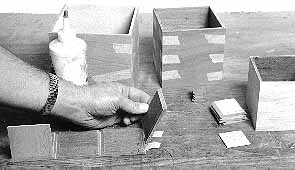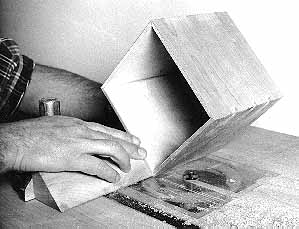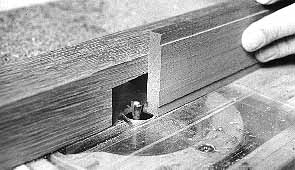Nested Boxes

Can you think of a better way to pop the question? She'll think you're a nut by the time she gets to the fourth box, but when she gets to the sixth, you'll be a nut worth marrying. Substitute a piece of candy or a marble for the ring, and you have an excellent gift for a youngster. Whatever you put in the last box, the recipient will have a lot of fun finding it.
This is a good project for using up smaller miscellaneous scraps. I used a bunch of pieces of 1/4" hardwood veneer plywood that I just couldn't throw away, but were too small for anything else. If you plane or resaw 3/4" thick stock down for this project, be sure to start with pieces at least 18" long for safety while planing or resawing. Bring them down to 1/4 or 3/8" in thickness. The exact thickness isn't critical.
Make the outside dimensions of the box parts in inch increments. The large box parts are 6" square, the next are 5" square, then 4, 3, etc. First rip your stock to these widths on the table saw. Do this with the blade at 90o, ripping on the long grain on the edges of the stock. Now set up your table saw cutoff box with the blade tilted to 45o to cut the miters on the ends on the parts. Use a toggle clamp to hold the parts in place as you do, not your fingers. This will require moving the clamp half way through because of the different widths- but- safety first.
Use 1/8" plywood for the box bottoms. You could also use 1/4" plywood if that's all you have, or even stiff cardboard. Cut a groove on the bottom inside edge of the box sides for the bottoms to fit into at the table saw or router table. Note that I didn't even try to do this with the tiny box- I just glued the bottom directly onto the bottom edge of the sides. Locate the groove at least 3/16" above the bottom edge of the sides, and make its width match the thickness of the bottoms. Use a push stick to help guide the parts across the cutter.
To glue the four sides of each box together, first lay them out with tape on three of the four joints as shown in photo 1. Apply glue to the eight mitered edges, place the box bottom in its slot, and fold the box together. Finally, tape together the fourth joint. Be sure that all the corners line up well and that each box is close to square before setting it aside to dry.


